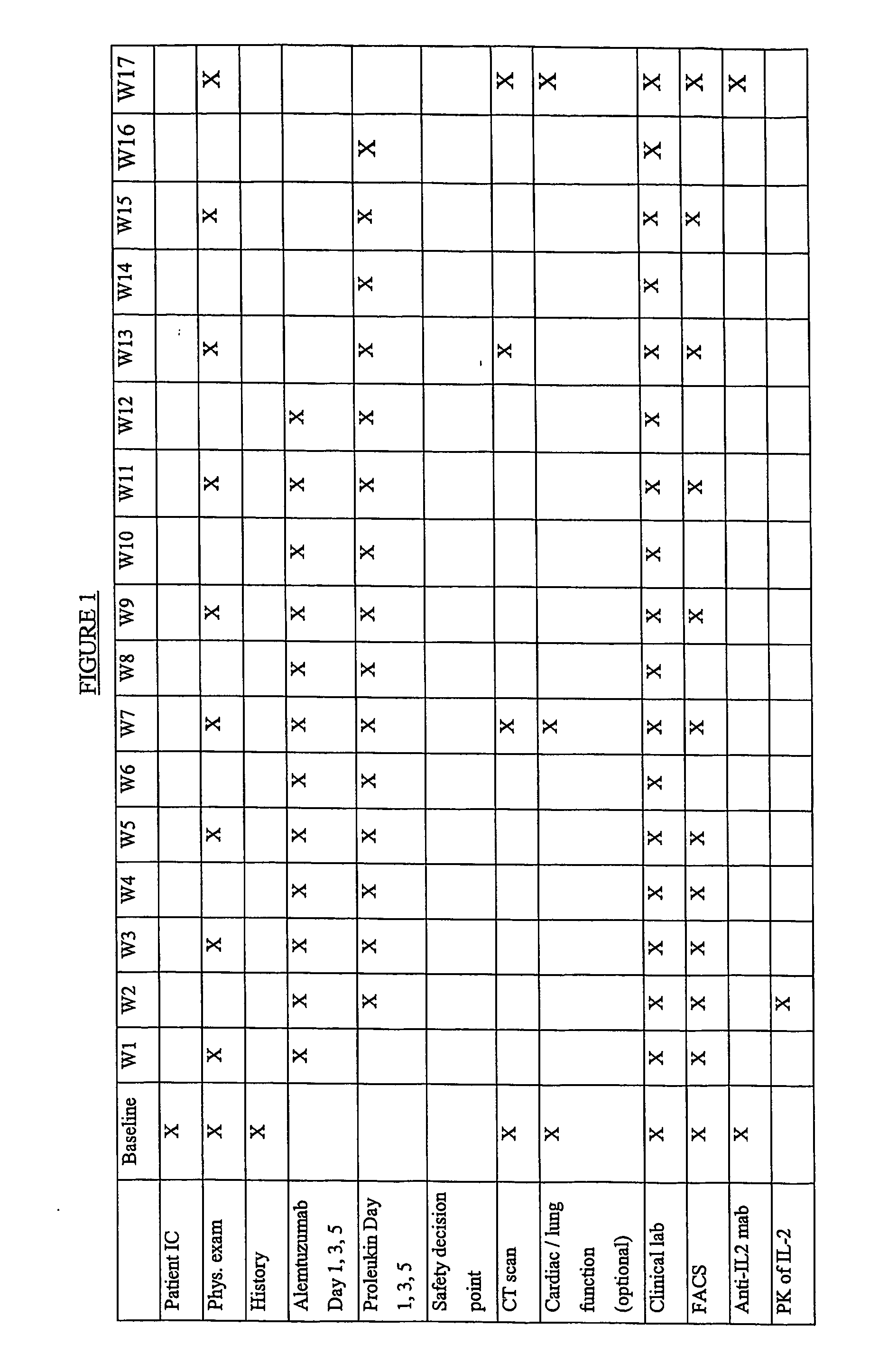Methods of Therapy for Chronic Lymphocytic Leukemia
a lymphocytic leukemia and therapy method technology, applied in the field of chronic lymphocytic leukemia therapy, can solve the problems of cll often becoming refractory to repeated courses of the same drug, depressed t-cell levels, and associated opportunistic infections, and achieve the effect of reducing side effects of anti-cd52 antibody administration and improving treatment safety
- Summary
- Abstract
- Description
- Claims
- Application Information
AI Technical Summary
Benefits of technology
Problems solved by technology
Method used
Image
Examples
example 1
Combination Treatment with an Anti-CD52 Antibody and an IL-2
[0148] This example describes an open label, uncontrolled trial. All subjects receive escalating doses (e.g., 3 mg-10 mg-30 mg on days 1, 3 and 5) of Alemtuzumab subcutaneously (SC) during week 1 until the dose of 30 mg SC is reached and well tolerated. If the intended escalation is not tolerated within 1 week, the escalation should be done within 2 weeks and all subsequent study procedures will also be delayed by one week.
[0149] Treatment with an IL-2 starts preferably on day 8 after the dose of 30 mg Alemtuzumab is reached. Subjects receive 3 weekly SC injections of IL-2 on the same days as Alemtuzumab for 11 weeks and then continue to receive IL-2 at the same dose for another 4 weeks after finishing the treatment with Alemtuzumab.
[0150] The first six subjects receive IL-2 at a dose of 10 MIU SC three times weekly for total 15 weeks. In case of dose-limiting toxicity (DLT) in 2 or more out of 6 patients the dose of IL-...
example 2
In Vivo Model Systems to Evaluate Campath® IH and IL-2
[0187] Campath®-1H is directed against the CD52 antigen, which is a 21-28 kDa MIU glycoprotein antigen that is coupled to the membrane by a glycophophatidylinositol (GPI) anchoring structure. CD52 is expressed on normal and neoplastic T and B-lymphocytes, natural killer (NK) cells, monocytes and monocyte-derived dendritic cells and macrophages, and tissues of the male reproductive system.
[0188] Human cell lines expressing CD52 include the B-cell line, Wien 133 Cl which expresses high levels of CD52, human non-Hodgkin's follicular B-cell lymphoma cell lines DoHH2 and BEVA carrying the t(14;18) translocation (Kluin-Nelemans et al. (1991) Leukemia S: 221; de Kroon et al., (1994). Leukemia 8: 1385-1391 and de Kroon et al. (1996) Exp. Hematol. 24: 919-926), human myeloid cell line expressing both FcR and CD52 molecules (THP-1; Lindmo et al., (1984) J. Immunol. Methods 72: 77-84; Fleit and Kobasiuk, (1991) J. Leukocyte Biol. 49: 556-...
example 3
Dosing Schedules of IL-2
[0191] Treatment with an IL-2 starts preferably on day 8 after the dose of 30 mg Alemtuzumab is reached. Subjects receive 3 weekly SC injections of IL-2 on the same days as Alemtuzumab for 11 weeks. The first six subjects receive IL-2 at a dose of 10 MIU SC three times weekly for total 11 weeks. After cessation of co-administration of Alemtuzumab and IL-2, a drug holiday will be given to the patient (four to six weeks). At this point the patient will receive cycles of IL-2 alone to restore T-cell counts. This regimen consists of administering an IL-2 twice a day for five consecutive days, followed by several weeks off of IL-2, for example, seven weeks off. (No IL-2 treatment is given during these weeks.) Each dose of IL-2 is 2-10 MIU, more usually 2-7.5 MIU, and an exemplary dose is 4.5 MIU, administered subcutaneously.
[0192] In case of dose-limiting toxicity (DLT) during co-administration of IL-2 and Alemtuzumab in two or more out of six patients, the dose...
PUM
| Property | Measurement | Unit |
|---|---|---|
| time | aaaaa | aaaaa |
| time | aaaaa | aaaaa |
| time | aaaaa | aaaaa |
Abstract
Description
Claims
Application Information
 Login to View More
Login to View More - R&D
- Intellectual Property
- Life Sciences
- Materials
- Tech Scout
- Unparalleled Data Quality
- Higher Quality Content
- 60% Fewer Hallucinations
Browse by: Latest US Patents, China's latest patents, Technical Efficacy Thesaurus, Application Domain, Technology Topic, Popular Technical Reports.
© 2025 PatSnap. All rights reserved.Legal|Privacy policy|Modern Slavery Act Transparency Statement|Sitemap|About US| Contact US: help@patsnap.com



